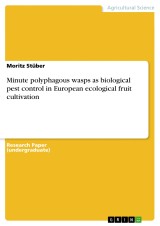Details

Minute polyphagous wasps as biological pest control in European ecological fruit cultivation
1. Auflage
|
13,99 € |
|
| Verlag: | Grin Verlag |
| Format: | |
| Veröffentl.: | 27.11.2018 |
| ISBN/EAN: | 9783668843943 |
| Sprache: | englisch |
| Anzahl Seiten: | 14 |
Dieses eBook erhalten Sie ohne Kopierschutz.
Beschreibungen
Research Paper (undergraduate) from the year 2018 in the subject Agrarian Studies, grade: 1,7, University of Hohenheim (Zentrum Ökologischer Landbau Universität Hohenheim), language: English, abstract: Mass releases of parasitic minute polyphagous wasps is a common biological pest control practice across the world. The application can reduce chemical insecticide use and therefore contribute to a more sustainable agriculture. Nearly all frequently used species derive from the genus Trichogramma. These wasps are released on several Million hectares of agricultural production, particularly in maize cultivation. This report is aiming to give an insight into a growing system, where Trichogramma practices are still under development. With regards to the application density, efficacy, applied species and environmental risks of Trichogramma in European ecological fruit cultivation was reviewed. The common application methods are lacking consistent results and pest control efficacy, since orchards differ greatly from the usual grain field cropping system. Three research directions to increase efficiency can be distinguished: new application methods (1); environmental attributes that favour Trichogramma (2) and suitable Trichogramma (mixtures) species (3). Development of equipment, suitable to disperse Trichogramma eggs more equally between rows is needed. A nozzle fan, spraying Trichogramma eggs, seemed to decrease costs and labour force by simultaneously increasing pest control consistency. Flower strips, particularly by containing buckwheat and mustard, can increase the longevity and fecundity of the wasps, leading to a better pest control performance. Local Trichogramma species should be preferred, as they are used to the climatic conditions and contribute to agroecological practices. The risk of mass releases on non-target insect species must be surveyed continuously. No significant effects were found, but off-field emigration does happen and needs to be monitored. The research implies the potential of Trichogramma to be used as an agroecological practice, being able to contribute to insecticide reduction. However, many results still need to be tested under commercial conditions.
Diese Produkte könnten Sie auch interessieren:

Agricultural Biodiversity and Biotechnology in Economic Development

von: Joseph Cooper, Leslie Lipper, David Zilberman

213,99 €

Policy Reforms and Agriculture Development in Central Asia

von: Sandjar Djalalov, Suresh Chandra Babu

213,99 €

Regulating Agricultural Biotechnology

von: Richard E. Just, Julian M. Alston, David Zilberman

213,99 €













